The World of Bees and everything that Revolves around Them 🐝
Bees constitute an immense zoological group that naturalists estimate in more than one million species. Bees have a body composed of three parts; the head formed by six or seven segments, the thorax formed by three segments, the abdomen formed by eleven segments. They have three pairs of legs two pairs of wings, a single pair of antennas, their development involves a metamorphosis.
The feeding is variable and the buccal apparatus presents an adaptation to their diet.
The salivary glands are well developed and may present specializations. The excretion takes place through special organs known as Malpighian tubule.
The nervous system includes a central part, the brain and a ventral nerve branch.
The sensory organs are very developed.
The circulatory system consists of a contractile heart and a blood vessel, the aorta.
The reproduction has many variations, in general the sexes are separated, the males have an external appearance different from the females.
The main role of bees is the pollination of the flowers, called Entomophily, unlike the wind-polluted Anemophily pollination.
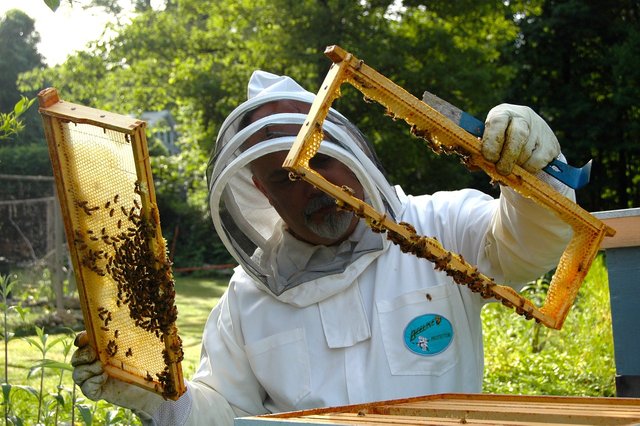
Classification
The most known bees are classified in hymenoptera , coleoptera , lepidoptera , diptera .
The so-called domestic bee belongs to the order of the hymenoptera. The essential characters of the hymenopterans are complete metamorphosis, membranous wings, accentuated sexual dimorphism, well-developed brain.
The Apidae family is subdivided into Melipona , Bombus , Trigona and Apis to which the domestic bee belongs. To the genus Apis belong four species the Apis cerana , the Apis florea , the Apis dorsata, and the Apis mellifica .
The bee cerana - or bee indica - is widespread in much of Asia China, Japan, India, much of Siberia, in the west of Afghanistan comes in contact with the honeybee. Bee colonies are not very populous and do not propolate, they are the object of breeding.
The Bee dorsata - is found in Southeast Asia to the Philippines is very aggressive and builds a single honeycomb outdoors, it is not a properly domestic bee.
The bee florea - has the same distribution of the bee dorsata but
is a small bee and builds a single honeycomb.
The honeybee - or western bee - seems to have developed in the Himalayan region and derives from the cerian bee. The honeybee is the most widespread of the genus Apis, this species populates Europe, Africa, Western Asia and after the exploration of the new continents was introduced in the Americas, Australia, New Zealand.
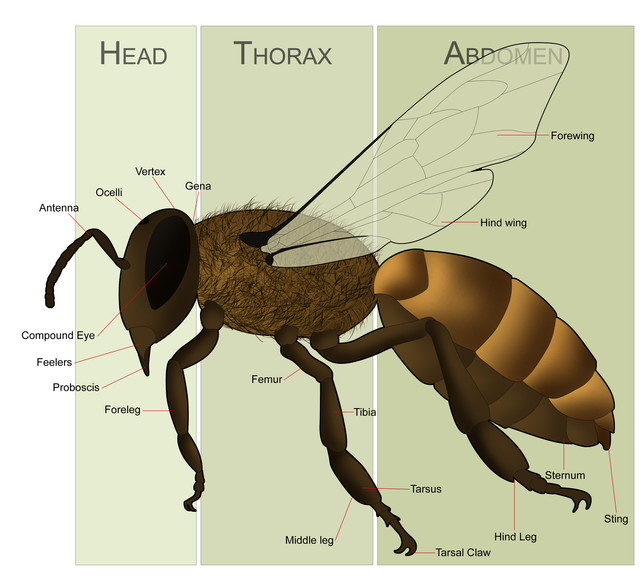
The External Morphology of Bees
The body of a adult working bee is covered by a protective layer, provided with bristles and hairs and is formed of three parts, the head , the thorax and the abdomen . The head and thorax are clearly distinct from the abdomen.
The head- of a working bee is roughly triangular, at the upper corners there are the compound eyes , two, of large dimensions. They are made up of thousands of small elements that allow the formation of the surrounding environment.
Beyond the compound eyes the bee has three simple eyes or ocelli, arranged on the front, their function seems to be to see objects very close, they work more like photo-electric cells than eyes.
The visual angle of the bees is near 360 °, they see the details of the objects badly, but they distinguish the shapes well. The bee can perceive some colors unlike the human eye that perceives colors from red to violet. The field of vision is contracted towards the red and dilated towards the ultraviolet (invisible to the human eye) for the bees is a real color.
The antennas-The antennas are cylindrical, L-shaped, with the base inserted into two membranous dimples. They are composed of thousands of sensilli which are: tactile , olfactory ,termorecettoriali.
Bees clean up antennas from atmospheric dust, so that sensory perception is optimal.
The buccal apparatus- Is located at the lower corner of the head and consists of the upper lip , two jaws , lower lip .
The upper lip with sensory sensations is very small.
The two jaws placed at the sides of the mouth shape the wax that comes out of the mandibular glands and build the honeycombs with it.
The two jaws, very mobile, made up of distinct articles, are used to attack opposing insects, to defend, to chew and open the operculum to bees.
The lower lip is originated by the fusion of a second pair of jaws, formed of various articles among them the ligule . The ligula is a kind of proboscis, the bee inserts it in the floral glass for the collection of the nectar that is sucked.
In the queen and in the drones the buccal apparatus is less developed and the drones do not have the mandibular glands.
The chest- is covered with hair that masks its segmentation. It consists of three segments, prototorace , mesothorax , metathorax, in the segments there are a dorsal lamina, a ventral and two lateral laminae.
Which are attached on its sides of the first pair of legs and the first pair of wings. The second pair of legs are attached to the mesothorax. The metathorax is the third segment, which bears the third pair of legs sideways.
The legs- Are used both for walking and for collecting pollen and for cleaning the body from any unknown particles. The legs are made up of a series of articulated segments covered with hairs.
The legs have particular characteristics: the anterior ones are shorter and have a witch (brush) in which the bee inserts the antennas to clean them from the pollen, so they always have the well-functioning sensilli.
The medium legs are sturdier and in the tibia there is a spur that serves the bee to remove the pollen from the baskets. The hind legs present on the outside of the tibia a concavity called basket, a place of accumulation of pollen pollinated on the flowers, brushes, rigid bristles with which the bee cleans the body smeared with pollen.
The wings- Are membranous and consist of two thin sheets, overlapped and close together and of a 'subtriangular' shape. At rest, the wings are placed horizontally above the abdomen. The hindquarters are smaller than the front ones, the particular hanging of the wings allows during the flight to win the air resistance and increase the speed.
The Abdomen- It is constituted morphologically by 10 segments. The abdomen is pedunculated and presents the first segment, called propodeo , incorporated into the metatorax. The other segments are in the dorsal part and the ventral part. Urosternites internally have ovoid formations corresponding to the ceripar glands .
The wax is produced only by the workers between the tenth and eighteenth day of life. The last ring of the abdomen, with the exception of the kelp, is provided with a sting .
The Sting- Is a toothed stylet with the backward-facing teeth connected to the venomous apparatus poison is a liquid that has antiseptic properties. When the bee stings the tip of the stinging stick into the victim's tissues and the sting remains attached and in the effort to withdraw it the abdomen tears, in a short time the bee dies. Bee venom is recognized as a therapeutic function in cases of rheumatic forms.
The drones are more conspicuous bee and are more stocky, their wings exceed the abdomen and have larger, contiguous compound eyes. The ligule is very short, and therefore can not collect the nectar. They do not have the sting.
The queen has the length of the major body of the worker and the drone and also the width of the thorax is greater, the length of the ligula is shorter than the worker, and the sting is smooth.
The Geometry of Bees
Bees in the wild build honeycombs where they deposit, in cells, the crop and breed the brood. The construction takes place with wax produced by the bees, which is secreted by eight small glands located under the abdomen. It is secreted in the form of a fluid that rapidly solidifies, perhaps by chemical reaction. A honeycomb is composed of two sides with hexagonal cells.
They do not build the cells with a circular section, as bumblebees do, because they would waste wax, instead they save wax so that each wall serves each time to divide two cells
There would be other possibilities for building cells so that a wall divides two cells, a triangular and a square section. Among these possibilities, (triangles, squares, hexagons) which is the most economical?
The amount of wax needed is minimal when the perimeter of a given polygon is as small as possible.
Calculating the perimeter of a triangle, a square and a hexagon with assigned surface. The surface is equal to 1 (S = 1) and respectively L3, P3, L4, P4, L6, P6, sides and perimeters of the triangle of the square and of the hexagon.
For the square L4 = 1; P4 = 4; S = 1 .
For the triangle P3 = 3 * L3; S = (L3 * L3 * SQUARE ROOTS OF 3) / 4 .
For hexagon P6 = 6 * L6; S = (6 * L6 * L6 * SQUARE ROOT OF 3) / 4 .
The numerical values, starting from the surface equal to 1 (S = 1), are P4 = 4 and with three decimal places P3 = 4.559 and P6 = 3.722 .
The smallest perimeter is P6, therefore less wax is consumed by constructing the hexagonal section cells.
Do the bees know the solution to the problem? Where does the ability to build hexagonal cells come from?
But where the instinct of the bees does something wonderful is in the construction of the bottom of the cells, because it corresponds to a minimum of surface and therefore of wax. In fact, the bottom of the cells is not flat but cusped.
The cell section is hexagonal, but the cell itself is in the form of a hollow prism with a cusped bottom. The bottom of each is not a plane perpendicular to the sides of the cells, the bottom is made up of three equal lozenges forming a concave surface.
The Construction of the Combs
The natural honeycomb is a construction of the bees inside the apiary in which honey and pollen are deposited for the sustenance of the larvae that will be born from the eggs. It is always built in pure wax, glandular secretion of the worker bees, about 25 mm thick and the interspace is 35-38 mm, so it remains for the bees a passage of about 10 mm between a honeycomb and the other.
The wax used in the construction of honeycombs is the one just secreted by the bees, with a white watercolor. Sometimes darker wax is used, obtained by gnawing older honeycombs.
The wax in the form of slender scales, with an average weight of 0.6 mg with peaks of up to 1.2 mg, emerges from the ventral region of the working bee between the fourth and seventh sternites. The scales are collected by the workers with the brushes of the legs of the third pair and then grabbed by the paws of the first pair, are moistened with saliva and worked.
The chemical composition of the wax is a mixture of over three hundred substances, hydrocarbons, esters and acids are prevalent. To produce the wax, the bee consumes enormous quantities of sugars, fructose, glucose and sucrose, consisting of chemical elements (C, H 2 , 0 2 ) that are combined together in the wax.
The construction of the natural honeycomb usually starts from above and originates in two or three different points while the lower angles hang freely and shrink in the shape of a U.
In the construction, the bees, form chains to compact groups, inside the temperature remains at 35 ° C needed to model the wax.
The construction starts from a cusp-shaped base with three inclined lozenges, on which the bees pressing at the same time on the sides raise the cell walls to the hexagonal shape, with an inclination sufficient to prevent the outflow of the stored liquid honey in the cells.
The honeycombs consist of two types of cells, of different sizes, cells for the worker bees and cells for the drones. The cells constructed, per square decimeter, are variable according to the breed of bees. Carnian and Caucasian breeds construct approximately 850 cells per square decimeter.
In the construction, regulating of cells, the bees perceive the gravitational field and the terrestrial magnetic field. In nature the bees build the honeycombs in parallel series in a constant direction, this way of building seems to be influenced by the Earth's magnetic field.
Installation of an Apiary
Things to consider before Choice of Place for your Apiary
The priority choice goes for places rich in scaly nettarifera flora and nearby pollen sources.
The bees' hauling radius is less than a kilometer, but they can also reach distances of 3-4 kilometers in case of scarcity of sources.
Pay attention to the microclimate of the area, avoid wetlands because they promote the development of fungi.
Choose a location far from noise, vibrations, power lines and electromagnetic fields, because they diminish the livability of bees.
The ideal accommodation should not be exposed to winds because the hot or cold winds impede the flight of bees and reduce the availability of nectar
Make sure of the availability of running water nearby, otherwise prepare drinking troughs with frequent replacement water. The water serves in the spring for breeding the brood, and in summer for the thermal regulation of the hive.
In the valleys place the hives at the bottom, so that the downward flight is done at full load.
The hives must be lifted from the ground to avoid humidity but above all to avoid the ants that are harmful because they feed on the wood of the hives.
The hives must also be placed with a slight slope forward to facilitate the outlet of condensation water that settles in the bottom.
Avoid the arrangement in rows, if possible make groups of 5-10 hives, or distance the rows of 5-6 meters, the extreme hives would become stronger for the phenomenon of the drift to the detriment of the central ones. To orient the bees you can color the hives with distinct colors, yellow, white, blue, bluish green.
Tools for the Apiary
When visiting the hives it is necessary to be dressed appropriately, Here are tools beekeeper must have:
The Beekeeper Mask: Is the most essential accessory, which perform a protective function for the face. Bees when they are disturbed react using the sting, the poison also affects even beekeepers.
The essential requirements of a mask must be lightness, practicality and good visibility. In the market there are several types, but all have a net in the front. There are square masks, round with a hat or without, but also masks with blouse and overalls. The color of the mask is generally clear, white or yellow because it reflects the sun's rays.
The Gloves: They are also protection against bee stings, there are various types of short or long to the elbow. The main feature of a good gloves must be the sensitivity and practicality in extracting the frames during visits, there are those who use rubber gloves but mostly leather gloves are used.
The smoker: is used since to smoke the nests and get honey from bees much easily. The smoker consists of a cylindrical boiler with a capacity of one or two liters in which the fuel is introduced, by a spout and a bellows in wood and leather. The bellows are used to blow air to the base of the cylinder through a hole.
The fuels used to produce smoke are those that favor its persistence. The smoke produced must be dense and cold, by operating the bellows is directed onto the canvas to calm the aggressiveness of the bees that rush downwards and gulp honey. The use of smoking must be moderate, the goal is to calm the bees and not to react violently. The best smokers are those with external metal protection, of different thermal conductivity, to avoid accidental burns.
The Lever:** Is required to lift and inspect the honeycomb. The covers, a moving part of the apiary, are fixed to the body of the apiary by bees with propolis and wax. The lever must have a flat and sharp end to wedge between the cover and the nest or the honeycomb, the other end is curved at right angles to extract the frames. Another lever used is that so-called scraper, useful for removing the propolis and wax between the frames and scrape the wax under the cover.
The Brush: Is made of a piece of wood, about 5 cm long bristles are inserted at one end. It is generally used by hobbyists when they pick up tiny honey from the honeycombs, however it is always useful to have it with them.
The Toolbox: Is a container with everything you need for any eventuality, material for small repairs, pins, felt-tip pens, scotches, pliers, etc. As an alternative to the toolbox, a tray with some frames is recommended.
Image sources are all from Pixabay and Commons Wikimedia
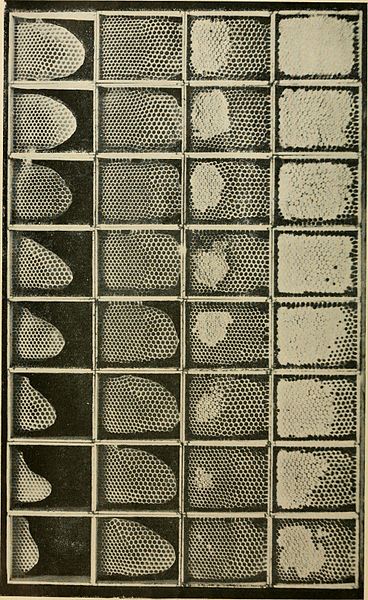
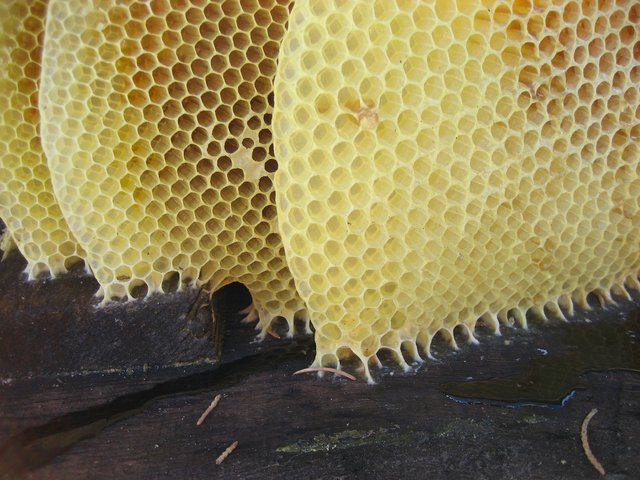
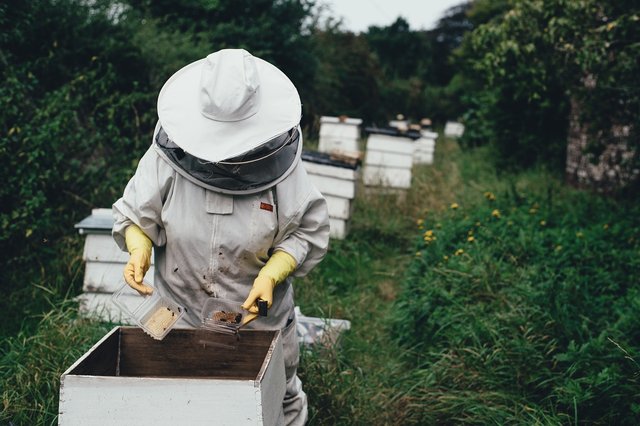
Hi rihanat,nice blog you habe here. You can consider using steemstem as one of your tags. They are the science community here on steemit.
OK, thanks @dorth
Congratulations @rihanat! You have completed some achievement on Steemit and have been rewarded with new badge(s) :
Click on any badge to view your own Board of Honor on SteemitBoard.
To support your work, I also upvoted your post!
For more information about SteemitBoard, click here
If you no longer want to receive notifications, reply to this comment with the word
STOPDo not miss the last announcement from @steemitboard!
Great post. Resteemed